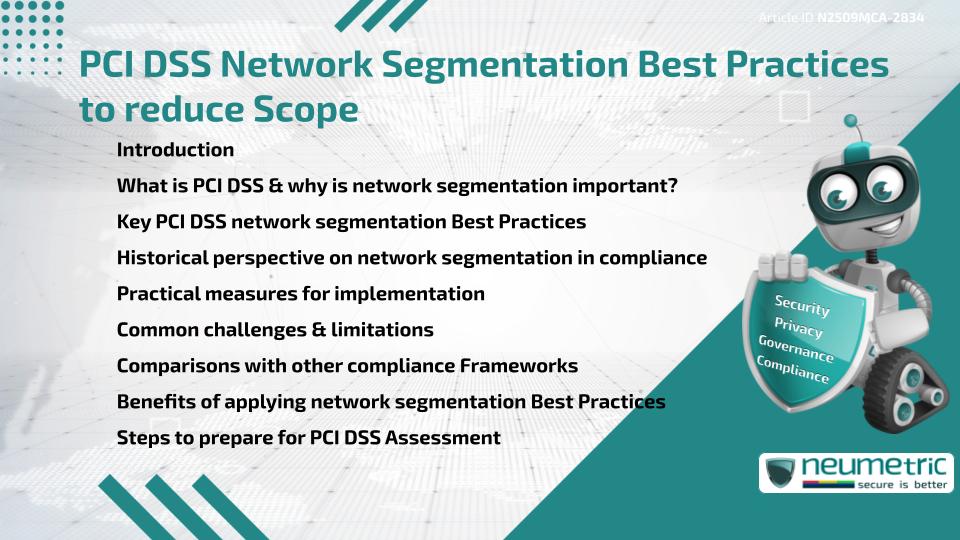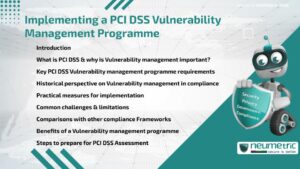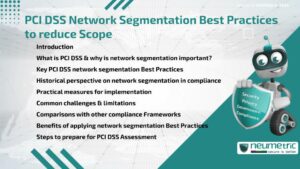Table of Contents
ToggleIntroduction
PCI DSS network segmentation Best Practices are essential for Organisations handling payment card data. Network segmentation reduces the scope of the Payment Card Industry Data Security Standard [PCI DSS] Assessment by isolating systems that store, process or transmit Cardholder Data. This article explores the importance, Best Practices, challenges & benefits of network segmentation, offering practical guidance for compliance.
What is PCI DSS & why is network segmentation important?
PCI DSS is a global security Standard that protects Cardholder Data & reduces fraud Risks. It applies to any organisation that processes, stores or transmits payment card information. Network segmentation is important because it limits the number of systems within the PCI DSS scope, reducing both compliance costs & Risks. Without segmentation, the entire network falls under PCI DSS requirements, making compliance far more complex.
Key PCI DSS network segmentation Best Practices
Organisations can apply several Best Practices to ensure effective segmentation:
- Isolate Cardholder Data environments (CDE) from other networks.
- Use firewalls & routers to enforce strict Access Control.
- Apply role-based Access Controls to limit User access.
- Monitor & log traffic between segmented networks.
- Regularly test segmentation effectiveness through Penetration Testing.
- Use strong authentication for administrators accessing the CDE.
These practices create barriers that protect Sensitive Data from unauthorized access.
Historical perspective on network segmentation in compliance
In the early days of PCI DSS, Organisations often struggled with compliance due to broad network scopes. Over time, segmentation was recognized as a practical solution to reduce the systems requiring compliance. This shift led to improved efficiency & lowered compliance costs, while still maintaining security for Cardholder Data.
Practical measures for implementation
To implement segmentation effectively, Organisations should:
- Identify systems that handle Cardholder Data.
- Define boundaries of the CDE.
- Configure firewalls & VLANs to separate networks.
- Restrict administrative access to segmented environments.
- Perform regular Vulnerability scans to validate segmentation.
Documentation of these measures is crucial for demonstrating compliance during assessments.
Common challenges & limitations
While beneficial, PCI DSS network segmentation Best Practices come with challenges:
- Complexity in large or hybrid networks.
- Potential misconfigurations in firewalls or routers.
- Difficulty in maintaining segmentation as systems evolve.
- Resource requirements for ongoing monitoring & testing.
Organisations must commit to continuous oversight & staff training to overcome these challenges.
Comparisons with other compliance Frameworks
Frameworks like ISO 27001 & NIST also encourage segmentation as part of defense-in-depth strategies. However, PCI DSS places stronger emphasis on segmentation because of the high value & sensitivity of payment card data. Unlike general Frameworks, PCI DSS explicitly rewards segmentation by reducing scope & compliance costs.
Benefits of applying network segmentation Best Practices
By following PCI DSS network segmentation Best Practices, Organisations achieve:
- Reduced scope for PCI DSS audits.
- Lower compliance costs & effort.
- Enhanced protection for Cardholder Data.
- Improved visibility & control of network traffic.
- Increased trust from Customers & business partners.
These benefits highlight the importance of investing in robust segmentation.
Steps to prepare for PCI DSS Assessment
To prepare for an Assessment, Organisations should:
- Map the Cardholder Data flow & identify CDE components.
- Validate segmentation with Penetration Testing.
- Maintain detailed network diagrams.
- Train staff on compliance responsibilities.
- Engage Qualified Security Assessors [QSAs] early to confirm readiness.
These steps ensure smoother assessments & long-term compliance.
Takeaways
- PCI DSS network segmentation Best Practices reduce compliance scope & Risks.
- Key measures include isolating CDEs, using firewalls & monitoring traffic.
- Challenges include complexity, misconfigurations & resource needs.
- Segmentation provides cost savings, stronger security & Customer Trust.
- Regular testing & documentation are essential for compliance.
FAQ
What are PCI DSS network segmentation Best Practices?
They are methods for separating Cardholder Data environments from the rest of the network to reduce compliance scope & protect data.
Why is network segmentation important in PCI DSS?
Because it limits systems in scope, reduces Audit costs & improves Data Protection.
How can Organisations validate network segmentation?
Through Penetration Testing, Vulnerability scans & reviewing network diagrams.
Does PCI DSS require network segmentation?
No, but without segmentation, the entire network is in scope, making compliance more difficult.
What challenges come with implementing segmentation?
Challenges include misconfigured firewalls, hybrid environments & resource limitations.
How often should segmentation be tested?
Regularly, typically annually or after major network changes, to confirm effectiveness.
Can segmentation lower compliance costs?
Yes, by reducing scope, segmentation decreases Audit effort & associated costs.
Need help for Security, Privacy, Governance & VAPT?
Neumetric provides organisations the necessary help to achieve their Cybersecurity, Compliance, Governance, Privacy, Certifications & Pentesting needs.
Organisations & Businesses, specifically those which provide SaaS & AI Solutions in the Fintech, BFSI & other regulated sectors, usually need a Cybersecurity Partner for meeting & maintaining the ongoing Security & Privacy needs & requirements of their Enterprise Clients & Privacy conscious Customers.
SOC 2, ISO 27001, ISO 42001, NIST, HIPAA, HECVAT, EU GDPR are some of the Frameworks that are served by Fusion – a SaaS, multimodular, multitenant, centralised, automated, Cybersecurity & Compliance Management system.
Neumetric also provides Expert Services for technical security which covers VAPT for Web Applications, APIs, iOS & Android Mobile Apps, Security Testing for AWS & other Cloud Environments & Cloud Infrastructure & other similar scopes.
Reach out to us by Email or filling out the Contact Form…





